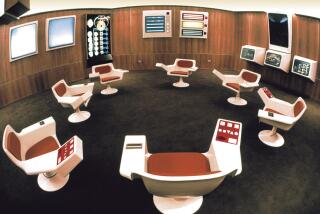Rather than risk letting their students experiment, they will pay for ours. : Soviets Import Computer Technology
- Share via
The videotape account of the VEGA mission followed a familiar trajectory: busy astronauts, the rocket silhouetted against bright sky and a computerized control room. It was almost too familiar. For VEGA is a Russian mission (VEGA combines acronyms for Halley and Venus, the objects of the flight), and the control room is somewhere in the Soviet Union. But the computers in mission control looked just like those at home.
Academician Roald Sagdeev, head of the Soviet Union’s unmanned space program, was in Pasadena last month for the Planetary Society. Yes, he said, explaining the similarity, much of the computerized instrumentation I was seeing had indeed been imported from the West.
Louis Friedman, executive director of the society, described the computers he saw on a visit to the Soviet Union in October, 1983. They seemed to be constructed from a melange of American and Soviet components, and had the peculiar look of naked engines, terminals with innards exposing their chips because there was no need for the commercially appealing design of outer skin.
First Computer Fair
It was only last month that the Soviet Union hosted the first computer fair in Moscow, and British and American companies had a chance to tout their wares. This followed the implementation on Jan. 1 of the Commerce Department’s new, more liberal regulations concerning the export of technology.
Already, it seems, eager Soviet buyers are talking in terms of purchasing thousands of American personal computers. These not-quite state-of-the-art Apple and IBM models are already available in every American shopping mall, and they are apparently destined for Soviet schools and scientific institutions.
The Soviets have, in effect, conceded that they have not developed good enough computer technology themselves. Moreover, they are acknowledging that they need efficient computers to keep up with the rest of the industrialized world in both science and technology. But rather than risk letting their students experiment in the fields of computer technology, they are prepared to pay for ours.
The computer is a dilemma that the Soviets have not quite worked out. Loren Graham, professor of history at MIT and a specialist in Soviet science, believes that the Soviet system may be stalemated in the matter of what to do about computers. Computer technology has certainly not developed as the Soviets expected. Several decades ago, he points out, when the term cybernetics had just been coined by the American mathematician Norbert Weiner to describe the science of machine-controlled processes, the Soviets embraced the new field as the “fulfillment of the revolution,” establishing courses in information theory in universities and setting up specially organized boarding schools for mathematically talented youngsters.
Basic Assumptions Challenged
The first generation of computers, those gigantic main-frames housed in institutions, seemed to be consistent with what the Soviets had in mind. They had plans to control the entire economy from a centralized data bank.
But the advent of personal computers with memory and calculating powers at least equal to the early institution-sized models changed everything. Graham points out that computers and computer culture challenge the very basis of the Soviet state; that is “state control over information and secrecy about vital data.”
At first it seemed as if gigantic computers could run the state, with an eye on every citizen. Now, however, the reality of microcomputers is that they provide independence for the individual. Computers allow clever people to ferret out secrets and thus subvert authority. It is impossible to imagine the Soviets allowing the establishment of computer “bulletin boards” and shared information, yet it is hard to stop such a process if individuals are allowed free access to computers.
Word processors, which so many Americans already take for granted, allow quick dissemination (in print or floppy discs) of written works. This is directly contrary to Soviet laws that prohibit private ownership of printing presses and copying machines.
A Talent for Programming
The development of computers and the software that they use has largely fallen to individual, often very young, entrepreneurs in this country. Independents with a talent for programming have supplied most of the innovative software that the large computer companies in the United States now market. “Hackers,” Graham remarks, are non-existent in the Soviet Union and will remain so as long as individuals are forbidden the freedom to experiment with computers.
The Soviet solution so far has been to keep computers inside the walls of scientific institutions like the one at the Soviet Space Agency, and hook up microcomputers to a main-frame so that no secret work can be done. This may well be successful for using computers to solve difficult problems in the sciences, but it will of necessity limit basic research in the science of the computers themselves.
The question that remains to be answered approaches the very nature of how science develops. Can an authoritarian system “fence in” innovative machines like computers and at the same time enable computer science to grow? So far the Soviets have faced their backwardness in computer technology by simply buying that technology from the West. But the West only sells information and hardware that is already commonplace and without military applications. It is hard to believe that the Soviets will want to continue picking up the leavings from our table. But without in some way loosening the bonds they have thrust upon their own citizenry, the Soviets will continue to lag further and further behind in an increasingly computer-dominated world.
More to Read
Inside the business of entertainment
The Wide Shot brings you news, analysis and insights on everything from streaming wars to production — and what it all means for the future.
You may occasionally receive promotional content from the Los Angeles Times.










